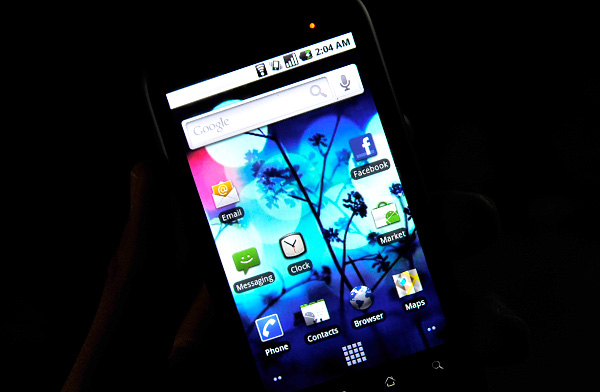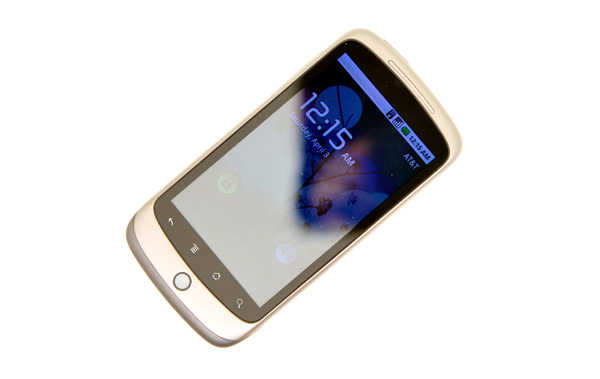Anand's Google Nexus One Review
by Anand Lal Shimpi on April 3, 2010 3:40 AM EST- Posted in
- Smartphones
- Mobile
The Display, My Love, the Display
If there’s one aspect of the Nexus One that makes the iPhone 3GS feel really dated it’s the display. Let’s look at the basic specs:
| Google Nexus One vs. Apple iPhone | |||||
|
Apple iPhone 3GS (ARM Cortex A8)
|
Google Nexus One (Qualcomm Snapdragon QSD8250)
|
||||
| Screen Technology | LCD | Active Matrix OLED | |||
| Screen Diagonal | 3.5" | 3.7" | |||
| Resolution | 320 x 480 | 480 x 800 | |||
| Pixels per Inch | 163 ppi | 252 ppi | |||
For very similar screen sizes (the Nexus One is narrower but longer than the iPhone), Google offers a huge increase in resolution. It makes sense given that the iPhone 3GS is still using the same resolution panel as the first iPhone back in 2007.
Recently Luke Hutchison published an excellent article at Ars Technica explaining the subpixel makeup of the Nexus One’s display. Most display technologies we’re used to reproduce colors by using a combination of red, green and blue. Instead of evenly distributing RGB subpixels across the display, the Nexus One has a combination of RRG or GBB for each pixel. This optimization is put in place most likely to reduce manufacturing cost or increase lifespan of the display.
Either way, you’re not getting complete color data on a per pixel basis. Now I won’t get into the argument of whether or not Google should call it a 480 x 800 display. It technically has that many pixels, it’s just that their makeup is a bit odd.

Google also does some pretty standard tricks to make the display look even more impressive. You get oversaturated colors and the usual trickery you can find in the TV section at Best Buy. Whites on the Nexus One aren't quite white but rather a cool blue and reds are often too red.
Compared to the iPhone, indoors, the Nexus One display is just incredible. If there are two things you could describe the Nexus One display as they would be: high contrast, and sharp. Indoors, and above 50% brightness, it’s honestly the best looking display I’ve ever seen on a smartphone. The colors are ridiculously vibrant and they pop because of the super deep blacks.

It really looks that contrasty.
The AMOLED display has no backlight, and thus it’s far more power efficient to display lots of black than it is to display bright whites. For this reason many of the applications use black backgrounds. For example, here’s the email app in Android vs. the email app in iPhone OS:
|
Google Nexus One
|
Apple iPhone 3GS
|
 |
 |
Given that Android is a fairly mainstream OS and not a pornsite, white text on a black background is generally unexpected. Unexpected, but not more difficult to read. The high resolution and incredibly contrasty AMOLED display make sure of that.

In direct sunlight, the lower part of the picture above is what the Nexus One looks like
Outdoors it’s another story entirely. In direct sunlight, the display is mostly useless at its default brightness settings. With the brightness cranked all the way up it’s still washed out but at least legible. Which brings me to my next point. The auto brightness control on the Nexus One is frustrating.

It automatically adjusts display brightness based on ambient light, but it generally picks a brightness that’s too low for my tastes. I just ended up disabling the automatic control and picked something that was around 50 - 100% brightness depending on what I was doing with the phone. I would like the option to have the auto brightness control pick settings that are a little less conservative.
Touch the Screen
Touchscreens have gotten much better over the past couple of years since the iPhone’s introduction. The Nexus One’s touchscreen is very close to as responsive as the iPhone’s but with some annoying issues. There are some situations where holding the Nexus One in one hand and swiping with my thumb won’t let me swipe between screens, and other similar accuracy issues. Getting the home bar buttons to recognize taps is also a pain at times. The touchscreen is definitely usable, just not as good as the iPhone's.










95 Comments
View All Comments
strikeback03 - Tuesday, April 6, 2010 - link
So does a 2mm difference in width really make that much difference in how you hold it and keyboard feel? As both phones are quite large compared to my HTC Diamond.Anand Lal Shimpi - Tuesday, April 6, 2010 - link
It really has to do with the autocorrect on the keyboard and key spacing it seems. I switched back to the Nexus One today and definitely make more errors that I have to manually correct, whereas the iPhone seems to do a better job of knowing exactly what I'm trying to say/type.The performance and screen are very nice on the Nexus One however :)
Take care,
Anand
Locut0s - Sunday, April 4, 2010 - link
Thanks for the great review Anand!! I've been thinking of getting a smart phone for some time now and have been eyeing either a Nexus one or whatever Apple does with their next iteration of their iPhone. This review has placed the Nexus one squarely in my top 3. As always fantastic writing, thanks! However I should point something as a reader living outside the US. Google Voice is still not available in Canada or anywhere else outside the US. So if you are reading this review and that feature sounds nice keep this in mind!!Chloiber - Sunday, April 4, 2010 - link
If you like the Google Nexus, read some reviews about the coming (in the next days - weeks) HTC Desire - I bet you like it even more :)Zokudu - Sunday, April 4, 2010 - link
Wonderful article Anand.This epitomizes what I love about your writing.
Keep up the great work
Anand Lal Shimpi - Sunday, April 4, 2010 - link
Thank you :)Take care,
Anand
Mumrik - Sunday, April 4, 2010 - link
"Most of the time you all scare the crap out of me. I want to impress, I want you guys to be happy with what I write. I want every article to be the most well received thing ever. Every writer wants that. No one ever gets it. So when I see comments telling me that you’re eagerly anticipating my Nexus One review, I get a turtle complex. And not the ninja kind."I don't think you need to worry too much about all that Anand. Your work over the last few years especially has been top-of-the-class.
Lifedelinquent - Sunday, April 4, 2010 - link
wonder if the htc evo will use the more updated snapdragon proc with the better gpu?Chloiber - Sunday, April 4, 2010 - link
It will use the Snapdragon QSD8650 (N1/Desire: QSD8250) with 1GHz.http://www.engadget.com/2010/03/23/htc-evo-4g-is-s...
Don't know what that implies about the built in GPU though.
LongTimePCUser - Sunday, April 4, 2010 - link
Anand,It sounds like your biggest problem with the Google phone was the on-screen keyboard.
Have you tried the slide-out keyboard on the Motorola Droid?
The big advantage is that you can see the entire display screen, including type-ahead suggestions, while typing.